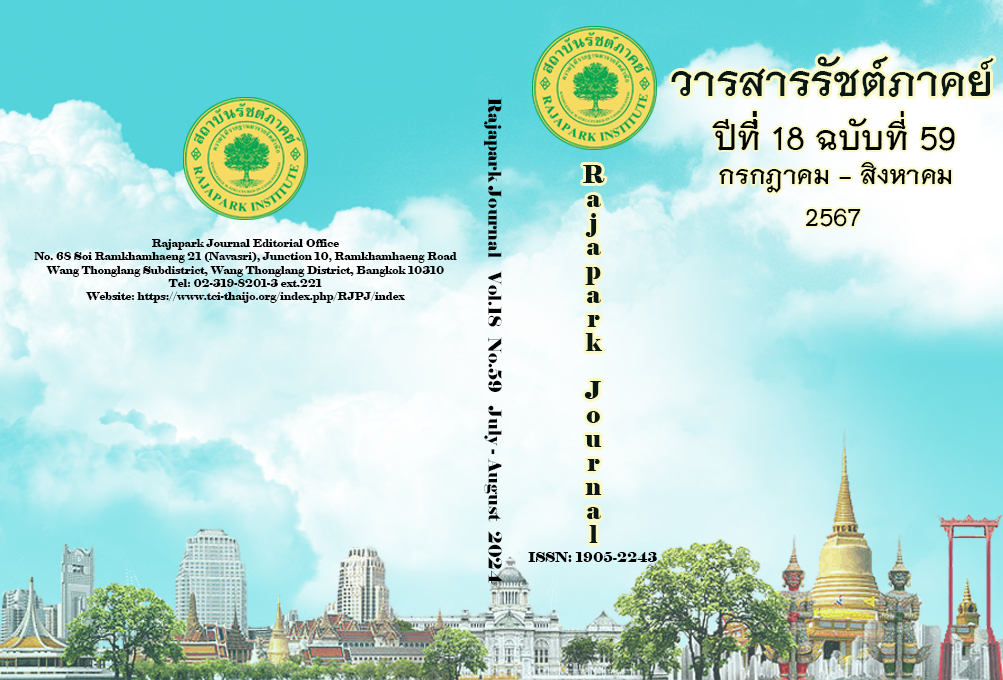The Academic Administration Under the Office of Surin Secondary Educational Service Area for Learning Organization
Main Article Content
Abstract
This research aimed to: 1) study educational institution management towards being learning organizations; 2) compare educational institution management towards being learning organizations classified according to the position and size of the educational institution; and 3) study guidelines for developing educational institution management under the Secondary Educational Service Area Office Surin towards being a learning organization. The samples were selected from 469 teachers and directors, resulting from determining the sample size using Taro Yamane's formula. The instrument used was a questionnaire, and the data were analyzed using a statistical package for social science consisting of percentage, mean score, standard deviation, and the hypothesis test using the T-test and F-test. The findings found that: 1) The educational institutions' management towards being learning organizations was at a high level overall. 2) The comparison of educational institution management towards learning organizations revealed that the classifications according to the position, overall and in each aspect, were not different. The size of educational institutions overall was not different. The consideration in each part showed that the personal mastery and the mental models were statistically different at a significant level. 05. 3) The guidelines for developing educational institution management towards learning organizations include using the Deming cycle (PDCA) to carry out various operations that focus on creating knowledge and skills for personnel, promoting the thinking process as a system step, supporting expressing opinions, creating a clear organizational vision, and moving in the same direction. Promoting team collaboration that emphasizes good interaction between personnel, designing and implementing information technology to organize the data systems, and encouraging a learning society by using technology for maximum benefit are also recommended as the guidelines.
Article Details

This work is licensed under a Creative Commons Attribution-NonCommercial-NoDerivatives 4.0 International License.
Views and opinions appearing in the Journal it is the responsibility of the author of the article, and does not constitute the view and responsibility of the editorial team.
References
Aramrat, S. (2019). Learning organization of schools under the secondary educational service area office 17[Master’s thesis, Rambhai Barni Rajabhat University].
Chaemkerd, J. (2019). Study of being a learning organization of educational institutions under the Chiang Rai primary educational service area office 3[Master’s thesis, University of Phayao].
Garvin, D. (1998). Building learning organizations. Havard Business Review, 71, 78-91.
Julsuwan, S. (2019). Change management in educational institutions. Taksila Printing.
Lorsuwannarat, T. (2009). Knowledge organization: From concept to practice (5th ed.). Rattanatrai.
Marquardt, M.J. (1996). Building the learning organization: A systems approach to quantum improvement and global success. McGraw-Hill.
Office of the Education Council, Ministry of Education, Thailand. (2014). Research report “Guidelines for the development of Thai education and preparation for the 21st century”. Office of the Education Council, Ministry of Education, Thailand. http://backoffice.thaiedresearch.org/uploads/paper/8368bcb7ab75d1bf068d8b5738a61727.pdf
Office of the Education Council, Ministry of Education, Thailand. (2017). National Education Plan 2017-2036. Office of the Education Council, Ministry of Education, Thailand. https://www.onec.go.th/index.php/page/view/Outstand/2532
Office of the National Education Commission. (2010). National Education Act B.E 2542 (1999) and Amendments National Education Act (No.2) B.E. 2545 (2002) and Amendments National Education Act (No.3) B.E. 2553 (2010). Office of the National Education Commission.
Panich, W. (2007). The way of an intelligent organization. Industrial Relations Bulletin, 73, 2-3.
Pankom, P., Thummarat, P., & Roypila, R. (2020). Academic leadership of teachers affecting the learning organization of school under the office of secondary educational service area 22. Journal of Educational Administration and Leadership, 9(34), 12-22. https://jeal.snru.ac.th/ArticleView?ArticleID=883
Robbins, S.P. (1998) Organisational behavior-concepts, controversies, and applications (8th ed.). Prentice Hall.
Sararatana, W. (2017). School of learning organization: Theoretical framework for educational administration. Thipayawisut.
Satchakett, W., & Julsuwan, S. (2021). Development of learning organization guidelines for extended opportunity schools under Khon Kaen primary educational service area office 5. Journal of Educational Administration and Supervision, 12(3), 140-152.
https://so20.tci-thaijo.org/index.php/JAD/article/view/223/125
Senge, P. (1990). The fifth discipline: The art and practice of learning organization. Doubleday.
Sincharu, T. (2012). Research and statistical analysis with SPSS and AMOS (13th ed.). R&D Business.
Siravadhakul, P. (2018). Good governance – based school administration affecting learning organization in public schools under the jurisdiction of secondary educational service area office 17[Master’s thesis, Rambhai Barni Rajabhat University].
Sudharatna, Y. (2010). Organization for learning (3rd ed.). Chulalongkorn University.
Sukkasi, A. (2017). A study of the role of school administrations in being a learning organization in administrations of basic education in Rayong, Chanthaburi and Trat provinces[Master’s thesis, Rambhai Barni Rajabhat University].
The Secondary Educational Service Area Office Surin. (2023). Basic Education Development Plan (2023-2027). Policy and Planning Group, The Secondary Educational Service Area Office Surin.


